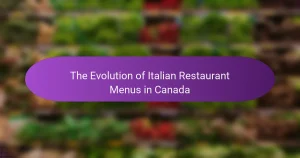
What are Traditional Cooking Techniques in Canadian Italian Cuisine?
Traditional cooking techniques in Canadian Italian cuisine include methods such as roasting, braising, and simmering. Roasting is often used for meats and vegetables, enhancing flavors through caramelization. Braising combines both moist and dry heat, typically involving browning meat before slow-cooking it in liquid. Simmering is a technique used for sauces and soups, allowing flavors to meld over low heat. These techniques reflect the Italian heritage while adapting to local ingredients and preferences. For instance, the use of local vegetables in traditional Italian recipes showcases this blend. The emphasis on slow cooking aligns with the Italian philosophy of savoring meals and family gatherings.
How do these techniques differ from traditional Italian cooking?
Canadian Italian cooking techniques differ from traditional Italian cooking in their incorporation of local ingredients and cultural influences. Canadian Italian cuisine often utilizes ingredients like maple syrup and wild game, which are less common in Italy. Techniques such as smoking and barbecuing are more prevalent in Canada, reflecting local culinary traditions. Additionally, Canadian Italian cooking may emphasize fusion with other Canadian cuisines, creating unique dishes. Traditional Italian cooking focuses more on regional recipes and techniques passed down through generations. The emphasis on simplicity and seasonal ingredients remains a common thread in both styles, yet the execution and ingredient selection can vary significantly.
What are the historical influences on Canadian Italian cuisine?
Canadian Italian cuisine is influenced by the migration patterns of Italian immigrants. The first significant wave of Italian immigrants arrived in Canada during the late 19th and early 20th centuries. They brought regional culinary traditions from various parts of Italy, including pasta, pizza, and risotto.
These immigrants adapted their recipes to local ingredients and tastes. For instance, they incorporated Canadian produce and meats into traditional dishes. The establishment of Italian markets and restaurants in urban centers further popularized these adaptations.
Additionally, post-World War II immigration increased the diversity of Italian cuisine in Canada. This led to the fusion of Italian cooking with other cultural influences present in Canada. Today, Canadian Italian cuisine reflects a blend of authentic Italian flavors and local Canadian elements.
How have local ingredients shaped these cooking techniques?
Local ingredients have significantly shaped traditional cooking techniques in Canadian Italian cuisine. The use of locally sourced produce influences flavor profiles and preparation methods. For instance, fresh vegetables from local farms enhance the authenticity of sauces. Seafood from nearby waters informs techniques like grilling and frying. Local grains contribute to the texture of pasta, making it unique to the region. Dairy products like cheese are often made from local milk, impacting recipes significantly. These ingredients encourage the adoption of preservation methods such as canning and pickling. The integration of local flavors fosters a sense of community and tradition in cooking practices. Overall, local ingredients serve as a foundation for evolving cooking techniques in this cuisine.
What are the key cooking methods used in Canadian Italian cuisine?
Key cooking methods in Canadian Italian cuisine include roasting, sautéing, and braising. Roasting is often used for meats and vegetables, enhancing their flavors through caramelization. Sautéing is a quick method that cooks food at high heat with minimal oil, preserving texture and taste. Braising combines moisture and slow cooking, ideal for tougher cuts of meat, making them tender and flavorful. These methods reflect traditional Italian techniques adapted to Canadian ingredients and preferences.
How is pasta traditionally prepared in this cuisine?
Pasta in Canadian Italian cuisine is traditionally prepared by boiling it in salted water. The water should be at a rolling boil before adding the pasta. Cooking time varies depending on the type of pasta, typically ranging from 8 to 12 minutes. It is essential to stir the pasta occasionally to prevent sticking. Once cooked, the pasta is drained but should not be rinsed. This method retains the starch that helps sauces adhere better. Traditional sauces often include tomato-based, cream, or pesto variations. Fresh ingredients are commonly used to enhance flavor, reflecting the regional produce available.
What role does roasting play in Canadian Italian cooking?
Roasting plays a significant role in Canadian Italian cooking. It enhances the flavors of meats and vegetables through caramelization and browning. Roasting is often used for preparing traditional dishes like porchetta and roasted peppers. The technique adds depth and complexity to the food. Canadian Italian cooks incorporate local ingredients, adapting traditional Italian recipes. This fusion creates unique dishes that reflect both cultures. Roasting also allows for a communal dining experience, as shared roasted dishes are common in family gatherings. The method promotes the use of seasonal produce, aligning with sustainable cooking practices.
What are the common tools and equipment used in these techniques?
Common tools and equipment used in traditional cooking techniques in Canadian Italian cuisine include a variety of utensils and appliances. These typically consist of pasta machines for rolling and cutting dough. Wooden spoons are essential for stirring and mixing ingredients. Cast iron skillets are often used for frying and sautéing due to their heat retention properties.
Other common tools include mortar and pestles for grinding spices and herbs. Knives, particularly chef’s knives, are crucial for chopping vegetables and meats. Mixing bowls are used for combining ingredients before cooking. Additionally, measuring cups and spoons ensure accurate ingredient proportions.
These tools and equipment facilitate the preparation of traditional dishes, helping to maintain authenticity in flavor and technique.
What traditional utensils are essential for Canadian Italian cooking?
Essential traditional utensils for Canadian Italian cooking include a pasta maker, wooden spoon, and gnocchi board. A pasta maker is crucial for rolling and cutting fresh pasta. Wooden spoons are ideal for stirring sauces and risottos. Gnocchi boards help shape and imprint gnocchi for better texture. Other important utensils are a colander for draining pasta and a rolling pin for dough preparation. These tools are commonly used in Italian kitchens and are essential for authentic preparation.
How do modern appliances complement traditional methods?
Modern appliances enhance traditional cooking methods by increasing efficiency and precision. For example, electric mixers streamline the process of making dough, which traditionally required manual labor. Instant pots and pressure cookers reduce cooking times significantly, allowing for quicker meal preparation while retaining flavors. Sous vide machines provide precise temperature control, ensuring that meats are cooked to perfection, a technique that aligns with traditional slow cooking. Additionally, food processors simplify tasks like chopping and blending, which can be time-consuming in traditional methods. These appliances allow cooks to focus on the artistry of cooking while reducing the physical effort involved. Overall, modern appliances support traditional methods by making them more accessible and less labor-intensive.
How do traditional cooking techniques enhance the flavors of Canadian Italian dishes?
Traditional cooking techniques enhance the flavors of Canadian Italian dishes by preserving authenticity and depth. Techniques such as slow cooking allow flavors to meld together over time. This results in richer sauces and more pronounced tastes. Additionally, methods like roasting and grilling infuse dishes with smoky undertones. The use of fresh, local ingredients in these techniques also contributes to vibrant flavors. For example, traditional pasta-making methods ensure the right texture and absorbency for sauces. Techniques such as simmering enhance the natural sweetness of tomatoes. Overall, these methods create a harmonious balance of flavors in Canadian Italian cuisine.
What are the flavor profiles characteristic of this cuisine?
Canadian Italian cuisine is characterized by a blend of rich, savory, and fresh flavor profiles. Common flavors include garlic, basil, and oregano, which provide a fragrant and herbal base. Tomato is a prominent ingredient, offering acidity and sweetness. Cream and cheese contribute to the richness and creaminess of many dishes.
Seafood, particularly in coastal regions, adds a briny and fresh taste. The use of hearty vegetables like bell peppers and zucchini enhances the overall flavor complexity. Spices such as red pepper flakes introduce heat, balancing the dish’s richness. The combination of these elements creates a unique culinary experience that reflects both Italian heritage and Canadian influences.
How does the cooking process affect the nutritional value of the dishes?
The cooking process significantly impacts the nutritional value of dishes. Cooking methods can alter the bioavailability of nutrients. For example, boiling vegetables can lead to the loss of water-soluble vitamins like vitamin C. Steaming, on the other hand, preserves more nutrients compared to boiling. Roasting can enhance flavor but may also reduce some vitamin content. High-heat cooking methods can cause the breakdown of certain antioxidants. Cooking can also improve digestibility by breaking down cell walls in plant foods. Overall, the choice of cooking technique is crucial for maximizing nutritional benefits.
What are some popular dishes that showcase these cooking techniques?
Popular dishes that showcase traditional cooking techniques in Canadian Italian cuisine include risotto, osso buco, and polenta. Risotto exemplifies the slow cooking method, allowing rice to absorb broth gradually for a creamy texture. Osso buco features braised veal shanks, cooked slowly to enhance flavor and tenderness. Polenta, made from cornmeal, is often simmered to achieve a smooth consistency. Each dish highlights the importance of patience and technique in traditional Italian cooking. These dishes are staples in Canadian Italian restaurants, reflecting the culinary heritage of the community.
What makes lasagna a staple in Canadian Italian cuisine?
Lasagna is a staple in Canadian Italian cuisine due to its rich flavors and versatility. It combines layers of pasta, meat, cheese, and sauce, creating a hearty dish. This dish reflects the Italian immigrant experience in Canada. Italian immigrants adapted traditional recipes to local ingredients. The use of ricotta, mozzarella, and ground beef is common in Canadian variations. Lasagna is often served at family gatherings and celebrations. Its popularity is supported by its comforting nature and ease of preparation. Many Canadians associate lasagna with home-cooked meals and cultural heritage.
How is risotto uniquely prepared in this culinary tradition?
Risotto in Canadian Italian cuisine is uniquely prepared by using Arborio rice, which has a high starch content. This rice is essential for achieving the creamy texture characteristic of risotto. The preparation begins with sautéing onions or shallots in olive oil or butter. Then, the Arborio rice is added and toasted briefly.
Next, hot broth is gradually added, one ladle at a time, allowing the rice to absorb the liquid slowly. This method enhances the rice’s creaminess while ensuring it cooks evenly. Stirring continuously is crucial, as it releases the starches and contributes to the dish’s final texture.
Finally, ingredients like Parmesan cheese, butter, and seasonal vegetables or proteins are incorporated just before serving. This technique reflects the Italian tradition of risotto while adapting to local Canadian ingredients.
What are some tips for mastering traditional cooking techniques in Canadian Italian cuisine?
To master traditional cooking techniques in Canadian Italian cuisine, focus on understanding the foundational recipes. Start by learning the classic dishes such as pasta, risotto, and sauces. Familiarize yourself with regional ingredients that define Canadian Italian cuisine, like local cheeses and fresh produce. Practice essential techniques like sautéing, simmering, and baking to build your skills. Use authentic tools such as a pasta maker or wooden spoon to replicate traditional methods. Experiment with variations while respecting the core flavors and techniques. Attend workshops or cooking classes specifically focused on Canadian Italian cuisine for hands-on experience. Engage with local chefs or culinary experts to gain insights and tips.
Traditional Cooking Techniques in Canadian Italian Cuisine focuses on methods such as roasting, braising, and simmering that enhance the flavors of dishes while reflecting Italian heritage and local adaptations. The article explores how these techniques differ from traditional Italian cooking through the incorporation of local ingredients, historical influences from Italian immigration, and the fusion with Canadian culinary practices. It also highlights key cooking methods, the significance of tools and equipment, and the nutritional impact of various cooking processes. Popular dishes like risotto and lasagna exemplify these techniques, showcasing the unique blend of authentic Italian flavors with Canadian elements.


